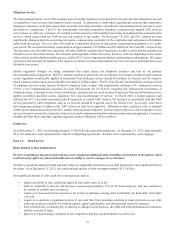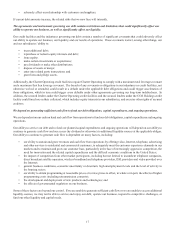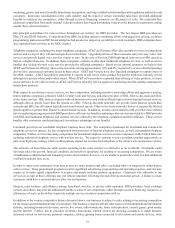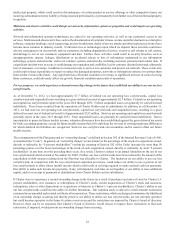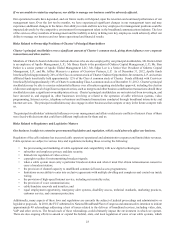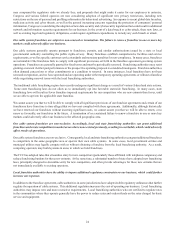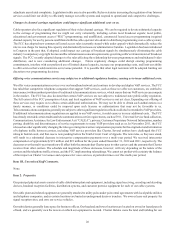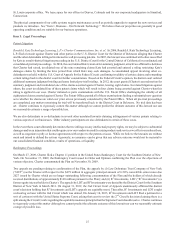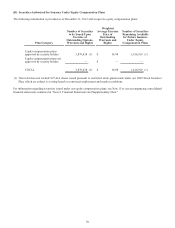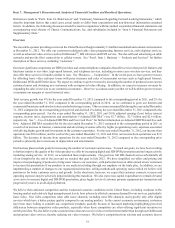Charter 2012 Annual Report Download - page 38
Download and view the complete annual report
Please find page 38 of the 2012 Charter annual report below. You can navigate through the pages in the report by either clicking on the pages listed below, or by using the keyword search tool below to find specific information within the annual report.26
adjudicate any related complaints. Legislation in this area is also possible. Rules or statutes increasing the regulation of our Internet
services could limit our ability to efficiently manage our cable systems and respond to operational and competitive challenges.
Changes in channel carriage regulations could impose significant additional costs on us.
Cable operators also face significant regulation of their video channel carriage. We can be required to devote substantial capacity
to the carriage of programming that we might not carry voluntarily, including certain local broadcast signals; local public,
educational and government access (“PEG”) programming; and unaffiliated, commercial leased access programming (required
channel capacity for use by persons unaffiliated with the cable operator who desire to distribute programming over a cable system).
The FCC has adopted new commercial leased access rules (currently stayed while under appeal) which dramatically reduce the
rate we can charge for leasing this capacity and dramatically increase our administrative burdens. Legislation has been introduced
in Congress in the past that, if adopted, could impact our carriage of broadcast signals by simultaneously eliminating the cable
industry’s compulsory copyright license and the retransmission consent requirements governing cable’s retransmission of broadcast
signals. The FCC recently adopted changes to the rules affecting the relationship between programmers and multichannel video
distributors, and is now considering additional changes. Future regulatory changes could disrupt existing programming
commitments, interfere with our preferred use of limited channel capacity, increase our programming costs, and limit our ability
to offer services that would maximize our revenue potential. It is possible that other legal restraints will be adopted limiting our
discretion over programming decisions.
Offering voice communications service may subject us to additional regulatory burdens, causing us to incur additional costs.
We offer voice communications services over our broadband network and continue to develop and deploy VoIP services. The FCC
has ruled that competitive telephone companies that support VoIP services, such as those we offer our customers, are entitled to
interconnect with incumbent providers of traditional telecommunications services, which ensure that our VoIP services can compete
in the market. The FCC has also declared that certain VoIP services are not subject to traditional state public utility regulation.
The full extent of the FCC preemption of state and local regulation of VoIP services is not yet clear. Expanding our offering of
these services may require us to obtain certain additional authorizations. We may not be able to obtain such authorizations in a
timely manner, or conditions could be imposed upon such licenses or authorizations that may not be favorable to us.
Telecommunications companies generally are subject to other significant regulation which could also be extended to VoIP providers.
If additional telecommunications regulations are applied to our VoIP service, it could cause us to incur additional costs. The FCC
has already extended certain traditional telecommunications carrier requirements, such as E911, Universal Service fund collection,
Communications Assistance for Law Enforcement Act (“CALEA”), privacy, Customer Proprietary Network Information, number
porting, disability and discontinuance of service requirements to many VoIP providers such as us. In November 2011, the FCC
released an order significantly changing the rules governing intercarrier compensation payments for the origination and termination
of telephone traffic between carriers, including VoIP service providers like Charter. Several entities have challenged this FCC
ruling in federal court, and that case is now pending before the Tenth Circuit Court of Appeals. The new rules, as they now stand,
will result in a substantial decrease in intercarrier compensation payments over a multi-year period. We received intercarrier
compensation of approximately $19 million and $23 million for the years ended December 31, 2012 and 2011, respectively. The
decreases over the multi-year transition will affect both the amounts that Charter pays to other carriers and the amounts that Charter
receives from other carriers. The schedule and magnitude of these decreases, however, will vary depending on the nature of the
carriers and the telephone traffic at issue, and the FCC implementing rulemakings. We cannot yet predict with certainty the balance
of the impact on Charter’s revenues and expenses for voice services at particular times over this multi-year period.
Item 1B. Unresolved Staff Comments.
None.
Item 2. Properties.
Our principal physical assets consist of cable distribution plant and equipment, including signal receiving, encoding and decoding
devices, headend reception facilities, distribution systems, and customer premise equipment for each of our cable systems.
Our cable plant and related equipment are generally attached to utility poles under pole rental agreements with local public utilities
and telephone companies, and in certain locations are buried in underground ducts or trenches. We own or lease real property for
signal reception sites, and own our service vehicles.
Our subsidiaries generally lease space for business offices. Our headend and tower locations are located on owned or leased parcels
of land, and we generally own the towers on which our equipment is located. Charter Holdco owns the land and building for our


